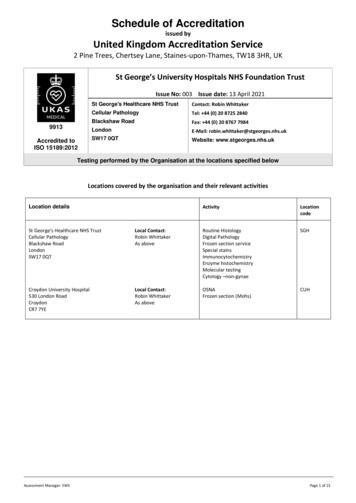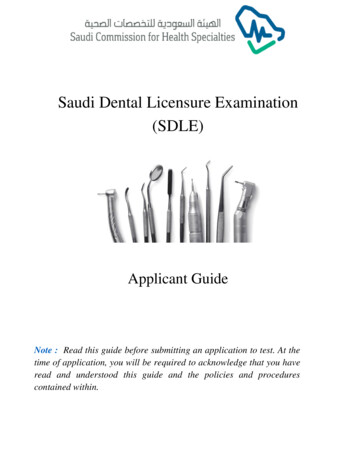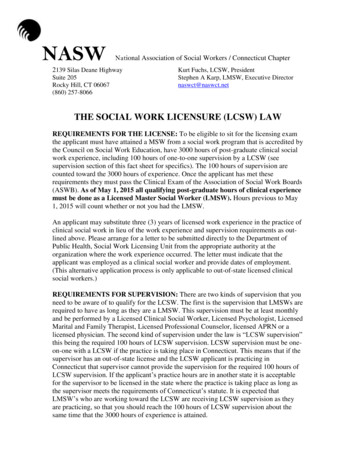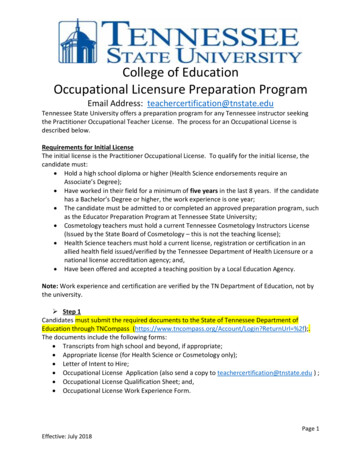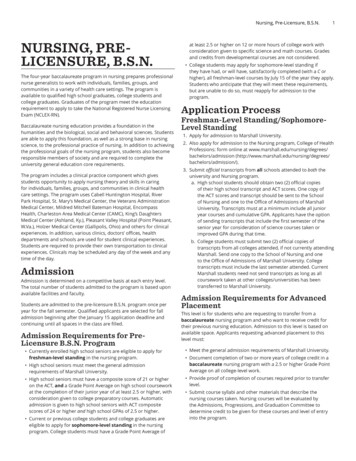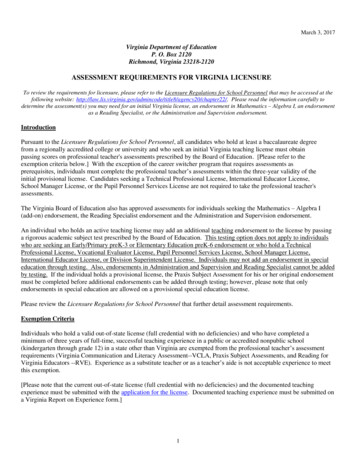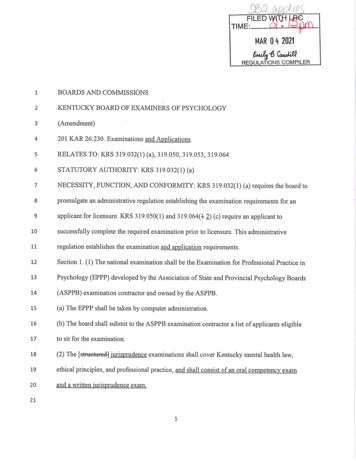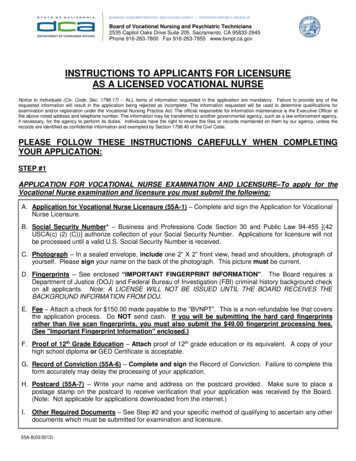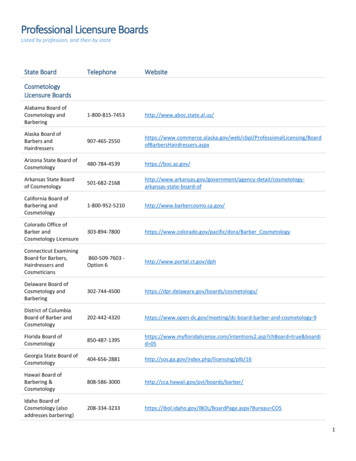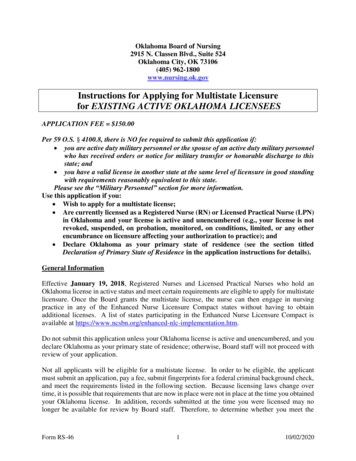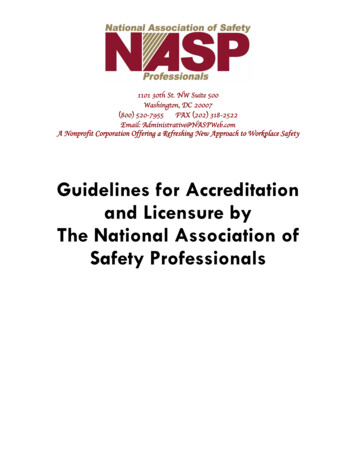
Transcription
1101 30th St. NW Suite 500Washington, DC 20007(800) 520-7955FAX (202) 318-2522Email: Administrative@NASPWeb.comA Nonprofit Corporation Offering a Refreshing New Approach to Workplace SafetyGuidelines for Accreditationand Licensure byThe National Association ofSafety Professionals
CONTENTSPART I: Principles of Accreditation and Licensure1A. The NASP Philosophy on Workplace Safety Management and TrainingPART II: The Accreditation Process5A. Criteria for Accreditation1. The Levels of NASP Accreditation and LicensureB. Separately Accredited UnitsC. Conditions of EligibilityPart III: Program Requirements11A. Organizational EffectivenessB. General Requirements of the Educational ProgramC. The NASP Safety Manager/Trainer CoursesD. Classroom Presentation of the Courses offered by NASP in Independent StudyFormatE. Courses offered by NASP in Independent Study FormatF. Publications Concerning NASP CoursesPart IV: Finances and Intellectual Property Rights12A. The Candidate OrganizationB. The Accredited and Licensed OrganizationPart V: Establishing NASP Chapters14Part VI: Application for Accreditation and Licensure15
Appendix A: The NASP Chapter Bylaws117
PART I: Principles of Accreditation and LicensureAccreditation of an organization by the NASP signifies that the organization has apurpose appropriate to workplace safety education and has resources, programsand services sufficient to accomplish its purpose on a continuing basis.Accreditation of an organization by the NASP includes licensure of theorganization by the NASP to use the NASP name, logo, and training materials,and to represent itself as NASP, except in the execution of contracts and liabilityassociated with its activity.Contracts and potential liability that may affect the NASP must be approved bythe NASP. In order to differentiate between the NASP and the accreditedorganization in such matters, the accredited organization will be assigned adescriptive name. An example would be “NASP Queensland” or “NASP Canada”.Accredited organizations may operate programs not accredited by NASP butthey may not utilize the NASP name or logo, or in any fashion represent suchprograms as being approved by the NASP. Organizations offering NASPprograms and safety programs not recognized by the NASP are cautioned thatthe NASP reserves the right to rescind accreditation for any reason, includingactions outside of NASP accreditation requirements that diminish the credibility ofthe organization.Accreditation by the NASP is the result of thorough and careful evaluation of theeducational quality of the organization. This qualitative evaluation dependsheavily on peer review by a visiting committee, and final evaluation by the NASP.Professional judgment in the peer review process goes beyond a simplecompliance audit of the minimum requirements in the Criteria and provides forquality assurance in accreditation.Criteria and procedures for accreditation have been developed which are used inevaluating an organization’s educational effectiveness. Initially and periodically,each accredited organization is evaluated by the NASP. Demonstratedcompliance with the Criteria for Accreditation and the Conditions of Eligibility,results in initial accreditation or reaffirmation of accreditation.The NASP reserves the right to make unannounced studies and visits toorganizations. Accreditation is specific to an organization, is based on conditionsexisting at the time of the most recent evaluation, and is not transferable. Whenan organization changes the nature of its affiliation or its ownership, asubstantive change review is required.1
A. The NASP Philosophy on Workplace Safety Management and TrainingAccreditation of an organization by the NASP signifies that the organizationagrees to represent the NASP philosophy on workplace safety in every situationin which they represent, or appear to represent, the NASP.Eight Principles of a Safe WorkplaceThe success of the National Association of Safety Professionals is a reflection ofNASP’s Eight Principles of Workplace Safety. While each NASP Certified SafetyManager or Trainer determines their own safety efforts, they are all joined inbasing their programs and training on a common safety philosophy. These eightprinciples, derived from the NASP Safety Philosophy, have given direction tohundreds of safety managers and trainers at locations worldwide.1. Safety is an Ethical Responsibility. At its core, ethics holds up a positivevision of what is right and what is good. It defines what is “worth” pursuing asguidance for our decisions and actions. Workplace injuries and deaths are toooften seen in the abstract as statistics. But when it happens to someone we love,we suddenly see the reality of the horrible pain and suffering, and its widespreadeffect. It is our ethical responsibility to do what is necessary to protect employeesfrom death, injury, and illness in the workplace. This is the only foundation uponwhich a true safety culture can be established in any workplace.2. Safety is a Culture Not a Program. The combined commitment andparticipation of the entire organization is necessary to create and maintain aneffective safety culture. Every person in the organization, from the topmanagement of the corporation to the newest employee, is responsible andaccountable for preventing injuries.3. Management is Responsible. Management's responsibility is to lead thesafety effort in a sustained and consistent way, by establishing safety goals,demanding accountability for safety performance, and providing the resourcesnecessary for a safe workplace. Managing safety is the responsibility of everysupervisor, from the first line supervisor to the Chairman of the Board.4. Employees Must Be Trained to Work Safely. Awareness of safety does notcome naturally; we all need to be trained to work safely. Effective trainingprograms both teach and motivate employees to be a productive part of thesafety culture.5. Safety is a Condition of Employment. The employer must exhaust everyreasonable means to lead, motivate, train, and provision employees to maintain a2
safe workplace. However, in the event the employee refuses to take the actionsrequired to work safely, the employer must utilize a system of progressivediscipline to enforce safety requirements and ensure either the cooperation of theemployee or the removal of the employee from the workplace in order to protectthe employee and their coworkers.6. All Injuries Are Preventable. Sometimes accidents occur without theapparent indication of fault or blame. But there is always some chain of eventsthat occurred leading up to the accident that, had we realized the eventualoutcome, someone could have interceded. The fundamental belief that injuriesare, by their nature, preventable is a catalyst that encourages us to preventinjuries.7. Safety Programs Must Be Site Specific with Recurring Audits of theWorkplace and Prompt Corrective Action. The purpose of the workplace auditis to discover and remedy the actual hazards of the site before they can injureworkers. Recurring hazard analyses, comprehensive inspections, and aggressiveinvestigation of accidents or near misses, discover potential workplace hazardsand identify weaknesses in safety plans, programs, policies, and procedures.Safety regulations and generic safety programs are not sufficient means todiscover hazards because they are not specific to the individual workplace. Asuccessful safety audit program is site specific. Whenever a safety deficiency isfound, prompt action is required both to overcome the hazard and to reinforce themessage that safety is a priority.8. Safety is Good Business. Reducing workplace injuries and illnesses reducesthe costs of workers' compensation, medical expenses, potential governmentfines, and the expenses of litigation. Effective workplace safety is not anexpense, it’s an asset.A properly managed safety culture based on these Eight Principles of WorkplaceSafety will produce employees who participate actively in training; identify andalert each other and management to potential hazards; and feel a responsibilityfor their safety and the safety of others. Accepting safety as an ethicalresponsibility demonstrates a sincere concern for each employee whichestablishes the foundation for an effective safety culture.The NASP Safety PhilosophyWorkplace safety programs are fundamentally based on one of three principles:Regulatory Compliance, Monetary Savings, or Ethics. Those whose programsare based solely on regulatory compliance are concerned with avoiding fines andcitations and base their safety decisions solely upon existing safety regulations.3
Those whose programs are based primarily on monetary savings are concernedwith reducing their cost from employee injury, illness, and death. Those whoseprograms are based on ethics are concerned with doing whatever is necessary toprovide a safe workplace. NASP emphasizes safety as an ethics issue withcompliance and monetary savings as tools to be used within that ethicalframework.Regulatory ComplianceMany employers feel that regulatory compliance and workplace safety are thesame thing. An army of “safety consultants” market their services by encouragingemployers to fear regulators, a fear which only exacerbates the problem. Most ofthe world’s workplace safety regulatory agencies make it clear that theirregulations are only minimum requirements.Violating a legal regulation and violating an ethical principle are not the samething. In fact, reducing ethics to little more than compliance may lead to morenon-compliance than if ethics were the guiding light for workplace safety."Compliance" means not transgressing the limits defined by law. Business andsociety need regulations and laws along with enforcement. Compliance is a goodthing, but compliance is not ethics and compliance does not guarantee a safeworkplace.Focusing exclusively on laws and regulations restricts attention to the edges ofthe playing field. Crossing this line means a penalty. However, always working asclose to the edges as possible makes it more likely to sneak or stumble acrossthe forbidden limit. Ethical principles of workplace safety do sometimes spell out"law-like" boundary conditions through written policies and procedures, but theseare based not on what is legal, but on what is right. Ethical boundaries areusually drawn well back from those legal edges we might otherwise trespass.The ethics question is "what is right?", and the answer often exceeds minimumregulatory requirements. A true facility safety culture can not be established on afoundation of regulatory compliance alone.Monetary SavingsOne safety manager who advocates using monetary savings as a foundation forworkplace safety programs writes: “We were not hired because our companieswere altruistic about providing an environment where employees did not get hurt.We were not hired because our companies were enamored with safety.However, we were hired because it makes good business sense. We were hiredto reduce the costs of workers' compensation, the medical costs resulting frominjuries, and the costs of potential OSHA citations.”4
Many employers do genuinely care about the safety of their employees, and dosee workplace safety as an ethical responsibility rather than a strict matter ofdollars and cents. The cost of injuries is a viable consideration and an excellenttool for a safety manager to use in justifying expenditures for workplace safety.But a safety program based solely upon saving the employer money is sorelymisguided. The writer of the above needs to accept their responsibility to educatetheir employer to the fact that safety is much more than just money, it is anethical responsibility. A true safety culture cannot be established on a foundationof saving money alone.EthicsAt its core, ethics holds up a positive vision of what is right and what is good. Itdefines what is worth pursuing as a kind of guiding star for our decisions andactions. Organizations that base their workplace safety on ethics will spend theirenergy articulating and pursuing positive principles, values, and virtues.Observing regulatory boundaries and reducing expenses from injuries areimportant, but they are secondary to the pursuit of the right and good.We salute those in the business of regulatory compliance for their substantialcontribution to workplace safety. We thank those who gave us the tactic of usingmonetary savings to help justify our safety budgets. But we affirm the higherpurpose of our ethical responsibility to be driven by what is right and proper toprotect employees from death, injury, and illness in the workplace. This is theonly foundation upon which a true safety culture can be established in anyworkplace.A Systems ApproachA systems approach to workplace safety provides the means for us to determinethe specific needs of our workplace and our employees as opposed toregulations that are designed in a broad and general fashion. Systems thinkingcomplements our natural tendency to break things down into manageable parts.Systems thinking explores expansionistic thinking, an approach that firstconsiders the context of a problem before breaking it down into its componentparts. A systems approach to workplace safety will include comprehensiveworkplace safety audits and thereby both meet and exceed government safetyregulations. The systems approach provides a site specific and comprehensiveapproach to workplace safety.PART II: The Accreditation ProcessNASP accreditation requires an organization's acceptance of certainresponsibilities, including commitment to the NASP accreditation process. An5
organization must be committed to participation in the activities of the NASP.This commitment includes an adherence to all NASP accreditation policies andprocedures.Each accredited organization is responsible for ensuring integrity in all operationsreflecting upon the NASP. Each organization must provide the NASP access toall parts of its operation related to the accreditation process. Organizations arealso expected to provide the NASP or its representatives with informationrequested and to maintain an atmosphere of openness and cooperation duringevaluations, enabling evaluators to perform their duties with maximum efficiencyand effectiveness.Each organization seeking accreditation or reaffirmation with the NASP mustdocument its compliance with the Conditions of Eligibility as outlined herein.A. Criteria for AccreditationThe Criteria for Accreditation applies to all organizations seeking accreditation. Itis designed to guide organizations through the accreditation process.Compliance with the Criteria for Accreditation is intended to ensure the quality ofits NASP accredited programs. The NASP shall apply the Criteria to allapplicants regardless of type of organization, whether for-profit, not-for-profit,private or public. The NASP grants or reaffirms accreditation only toorganizations which comply with the criteria.An organization must refrain from making any substantive change in NASPprograms without the express approval of the NASP.The NASP maintains a policy and procedure for considering formal complaintsregarding accredited organizations. Each accredited organization must haveadequate procedures for addressing written student complaints concerningNASP related programs. Every formal written complaint received by theaccredited organization must be answered, in writing, within ten working days ofreceipt. The response to the complainant must include an explanation that thecomplainant has the right to appeal the decision of the accredited organization tothe NASP. Such an appeal must be made in writing to the NASP headquarterswithin ten working days of the receipt by the complainant of the response fromthe accredited organization.Each accredited organization must require that each trainer provide anopportunity for anonymous evaluation from each student at the conclusion ofeach course. These evaluations must be in writing, in a format approved by theNASP and must be maintained by the accredited organization for two years.6
These evaluations must be made available to the NASP for review at any timerequested.The NASP evaluates not only compliance with specific criteria, but also theeffectiveness of the organization’s training presentations and the environment inwhich teaching and learning occurs. Assessment of the overall effectiveness ofan organization’s training and its representation of the NASP workplace safetyphilosophy shall be an overriding factor in the NASP's determination of whetherto confer, or to continue, the accredited status of an organization.1. The Levels of NASP Accreditation and LicensureOrganizations are accredited and licensed by NASP in accordance with theseguidelines. The trainers employed by the accredited organization are certified inaccordance with NASP requirements.Each accredited and/or licensed organization is classified according to thehighest level of certification the organization is authorized to offer. The followingclassifications are used:Level I - These organizations are authorized to form a Chapter of the NASP for adefined geographical area and use the NASP logo and name. The NASPChapter may establish membership and charge membership dues in addition toNASP National membership dues. All Chapter members must be NASPmembers. The purpose of a Chapter of the NASP is to promote the enhancementof workplace safety, and to provide support and encouragement to thoseresponsible for managing and/or promoting workplace safety. In fulfilling itspurpose, the Chapter shall have the following objectives within the specifiedgeographical area: To develop and/or promote education programs for individuals interestedin obtaining the knowledge required to perform the functions of a safetyprofessional To develop and/or disseminate information and carry out the purposes ofthe Chapter and the NASP To provide and/or support forums for the acquisition and interchange ofprofessional knowledge among its members To foster liaison with local business and industry To inaugurate and implement other programs that are consistent with thepurposes of the Chapter and the NASP To conduct its affairs in a manner that will reflect the standards, purposes,and objectives of the NASP7
To inaugurate and implement other activities approved by the Chapter andthe NASPLevel II - These organizations are authorized to award NASP certificates and/orpocket cards within the limitations of their trainers training and experience, in anytopics for which they have successfully completed an NASP independent studycourse, or the topics listed below which were included in their NASP SafetyManager/Trainer Course. All trainers awarding NASP certificates and/or pocketcards, or representing themselves as NASP Trainers, or in any fashion using theNASP logo must be certified to the Safety Training Specialist (STS) level. STScertification requires the successful completion of the forty hour NASP SafetyManager/Trainer Course.Approved Courses for the STS: The Essence of the Successful Safety Culture Creating a Safety Culture that Really Works Understanding OSHA Civil & Criminal Liability for the Safety Professional Civil & Criminal Liability for the Manager/Supervisor Safety Training Methods That Work Safety Plans/ Programs That Save Lives Safety Self-Inspections What's New Regulatory Overview Bloodborne Pathogens Confined Space Entry Electrical Safety Ergonomics Hazard Communication Hazardous Materials HAZWOPER Inspections, Citations, Fines Lockout Tagout Machine Guarding Materials Handling Egress/Fire Safety PPE Record Keeping Workplace Violence Walk/Work Surfaces Weld/Cut/Braze8
Level III - These organizations are authorized to deliver a classroom version ofthe NASP Independent Study Courses and award NASP Certifications for thosecourses. Course material and training methodology
programs as being approved by the NASP. Organizations offering NASP programs and safety programs not recognized by the NASP are cautioned that the NASP reserves the right to rescind accreditation for any reason, including actions outside of NASP accreditati
